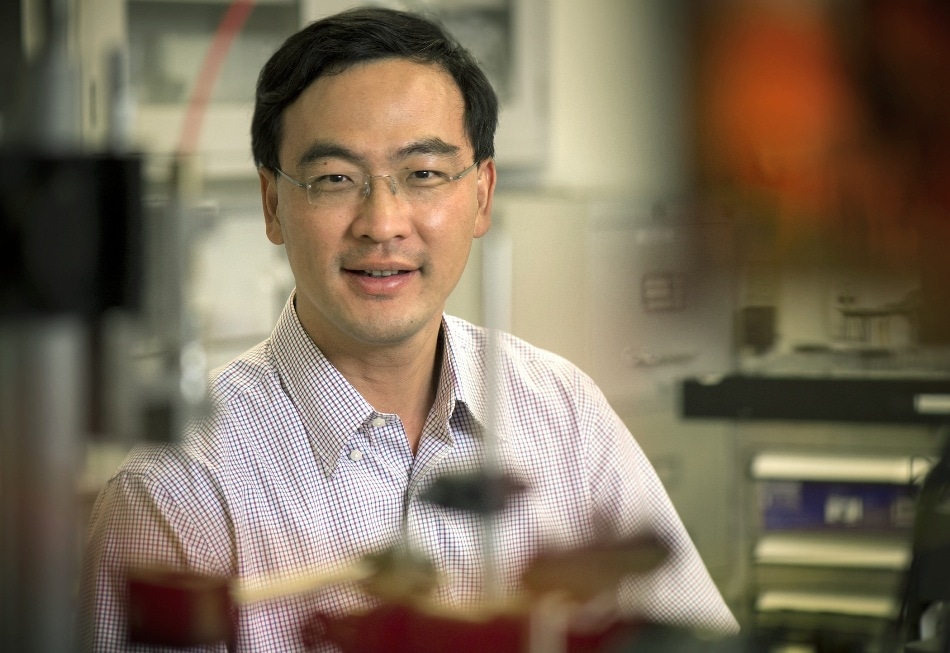Jun 5 2017
Conventional high-power lasers are hard to employ in portable platforms as they are bulky and require equipment. A University of Texas at Arlington Engineer is currently working to develop a semiconductor laser that will resolve those issues.
 Weidong Zhou, UTA Professor of Electrical Engineering, received a Multidisciplinary Research Initiatives grant. (Credit: University of Texas at Arlington)
Weidong Zhou, UTA Professor of Electrical Engineering, received a Multidisciplinary Research Initiatives grant. (Credit: University of Texas at Arlington)
Weidong Zhou, a Professor in the Electrical Engineering Department, is the main investigator in a five-year, $3 million Multidisciplinary Research Initiatives grant from the High Energy Laser Joint Technology Office to design a high-power semiconductor laser that is compact, power-scalable and efficient.
Zhou is partnering with Ganesh Balakrishnan of the University of New Mexico, Shanhui Fan of Stanford University and the Air Force Research Laboratory.
Semiconductor lasers use a cavity to generate feedback that bounces light to and from, ultimately transmitting the light from the face of the laser.
The laser has become a vital tool in building the next generation of innovative technologies, with projected revenue of over $10 billion in 2016.
However there are challenges that still remain in scaling laser power toward kilo and mega-watts level, while preserving exceptional beam quality, compact size and high-energy efficiency.
Zhou and the team will depend on nanotechnology principles and structures for realizing power-scalable, high-power lasers.
We have been looking at various aspects of lasers in areas where higher-power infrared lasers would be highly desirable – the military, manufacturing and security, for example – and how to address the major challenges associated with those applications. If we are successful in creating a semiconductor laser based on nanotechnologies, we can greatly reduce the size of these lasers while increasing their power and efficiency.
Professor Weidong Zhou, the Electrical Engineering Department, University of Texas at Arlington
The laser could finally be constructed on a semiconductor wafer. Control electronics and packaging essential to operate the laser could increase its size to that of a computer, significantly smaller than present laser operation systems.
Some potential applications for these lasers would be precision laser-cutting and 3D machining that could be achieved on a tabletop machine instead of a machine that consumes much of a room and LiDAR (Light, Detection and Ranging) sensing for autonomous vehicles. LiDAR provides autonomous vehicles awareness of their surroundings. Smaller systems also would be a lot more cost-effective.
Zhou is a Fellow of the International Society for Optical Engineering. He has over 300 journal publications and conference presentations. He entered UTA in 2004 after a brief career in the industry. He has been the Chief Investigator on research grants totaling almost $8 million and has been a part of over 40 projects totaling beyond $20 million since 2004.
The Electrical Engineering Department is an integral component of UTA’s College of Engineering, which is the third-largest in Texas with an enrollment of over 7,200.
Peter Crouch, Dean of the College of Engineering, commended Zhou’s innovations as a model of the University’s research to advance Global Environmental Impact under the Strategic Plan 2020: Bold Solutions | Global Impact.
Dr. Zhou has long been a leader in nanotechnology and optics, and this new grant could change how lasers are used. If lasers are smaller, lighter and less costly, they can be applied to many more platforms, with possibilities for their use that have not been considered previously.
Peter Crouch, Dean of the College of Engineering
A number of other UTA Electrical Engineers are conducting research in optics, including:
- Assistant Professor Alice Sun earned a National Science Foundation CAREER award in 2016 and has been the Chief Investigator on research grants totaling above $900,000 since starting her career at the UTA in 2013. Her research interests include optofluidic biomedical and chemical sensing; microfluidics and point-of-care devices; nanophotonics and biophotonics and bio-inspired photonic devices and systems.
- Professor Robert Magnusson is a charter Fellow of the National Academy of Inventors and a Life Fellow of the Institute of Electrical and Electronics Engineers. He heads UTA’s Nanophotonics Device Group, which focuses on theoretical and experimental research in periodic nanostructures, nanophotonics, nanolithography, nanoplasmonics, nanoelectronics, and optical bio- and chemical sensors. Magnusson has 30 issued and pending patents and has brought in over $10 million in research funding and endowments for UTA since becoming the Texas Instruments Distinguished University Chair in Nanoelectronics in 2008.
- Professor Michael Vasilyev is a Fellow of the Optical Society and has 10 issued patents. His research concentrates on nonlinear and quantum optics, nanophotonics and optical communication systems and devices. He has been the Chief Investigator on research grants totaling over $3.4 million since joining UTA in 2003.